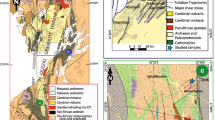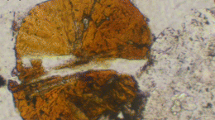Abstract
Spinels, Fe–Ti oxide minerals, apatites, and carbonates hosted in ophiolitic serpentinites and metagabbros of Gabal Garf (southern ED) and Wadi Hammariya (central ED) of Egypt are discussed. Microscopic and electron probe studies on these minerals are made to evaluate their textural and compositional variations. Alteration of chromites led to form ferritchromite and magnetite; rutile–magnetite intergrowths and martite are common in serpentinites. Fine trillis exsolution of ilmenite–magnetite and ilmenite–hematite and intergrowth of rutile–magnetite and ilmenite–sphene are recorded. Composite intergrowth grains of titanomagnetite–ilmenite trellis lamellae are common in metagabbros. The formation of ilmenite trellis and lamellae in magnetite and titanomagnetite indicate an oxidation process due to excess of oxygen contained in titanomagnetite; trapped and external oxidizing agents. This indicates the high P H2O and oxygen fugacity of the parental magma. The sulfides minerals include pyrrhotite, pyrite and chalcopyrite. Based on the chemical characteristics, the Fe–Ti oxide from the ophiolitic metagabbros in both areas corresponds to ilmenite. The patites from the metagabbros are identified as fluor-apatite. Carbonates are represented by dolomites in serpentinites and calcite in metagabbros. Spinel crystals in serpentinites are homogenous or zoned with unaltered cores of Al-spinel to ferritchromit and Cr-magnetite toward the altered rims. Compared to cores, the metamorphic rims are enriched in Cr# (0.87–1.00 vs. 0.83–0.86 for rims and cores, respectively) and impoverished in Mg# (0.26–0.48 vs. 0.56–0.67) due to Mg–Fe and Al (Cr)–Fe3+ exchange with the surrounding silicates during regional metamorphism rather than serpentinization process. The Fe–Ti oxides have been formed under temperature of ~800 °C for ilmenite. Al-spinels equilibrated below 500–550 °C, while the altered spinel rims correspond to metamorphism around 500–600 °C. Geochemical evidence of the podiform Al-spinels suggest a greenschist up to lower amphibolite facies metamorphism (at 500–600 °C), which is isofacial with the host rocks. Al-spinel cores do not appear to have re-equilibrated completely with the metamorphic spinel rims and surrounding silicates, suggesting relic magmatic composition unaffected by metamorphism. The composition of Al-spinel grains suggest an ophiolitic origin and derivation by crystallization of boninitic magma that belonging to a supra-subduction setting could form either in forearcs during an incipient stage of subduction initiation or in back-arc basins.






Similar content being viewed by others
References
Abdel Aal AY, Farahat ES, Hoinken G, El-Mahalawi MM (2003) Ophiolites from the Egyptian Shield: a case for a possible inter-arc origin. Mitt Oesterr Ges 148:81–83
Abdel-Karim AM, Soliman MM, El-Kazzaz YA, Mazhar AA, Abdel-Gawad GM (2001) Geological and geochemical characteristics of the Mafic-Ultramafic Rocks of Gabal Garf Area, Southeastern Desert of Egypt. Annals Geol Surv Egypt XXIV:193–218
Abdel-Karim AM, Azzaz SA, Moharem AF, El-Alfy HM (2008) Petrological and geochemical studies on the ophiolite and island arc association of Wadi Hammariya, Central Eastern Desert, Egypt. Arab J Sci Eng 33:117–138
Abdel-Karim AM, Ahmed Z (2010) Possible origin of the ophiolites of Eastern Desert, Egypt, from geochemical perspectives. Arab J Sci Eng 35(1A):115–143
Ahmed AH, Arai S, Attia AK (2001) Petrological characteristics of the Pan African podiform chromitites and associated peridotites of the Proterozoic ophiolite complexes, Egypt. Miner Deposita 36:72–84
Ahmed AH (2007) Diversity of platinum-group minerals in podiform chromitites of the late Proterozoic ophiolite, Eastern Desert, Egypt: genetic implications. Ore Geol Rev 32:1–19
Akaad MK, Abu El Ela AM (2002) Geology of the basement rocks in the eastern half of the belt between latitudes 25○ 30` and 26○ 30` N, Central Eastern Desert, Egypt. Geol Surv 78:118
Arai S, Yurimoto H (1994) Podiform chromitites of the Tari-Misaka ultramafic complex, Southwestern Japan, as mantle-melt interaction products. Econ Geol 89:1279–1288
Arai S, Uesugi J, Ahmed AH (2004) Upper Crustal Podiform Chromitite From The Northern Oman Ophiolite as the Stratigraphically Shallowest Chromitite in Ophiolite and Its Implication for Cr Concentration. Contrib Miner Petrol 147:145–154
Arai S, Shimizu Y, Ismail SA, Ahmed AH (2006) Low-T formation of high-Cr spinel with apparently primary chemical characteristics within podiform chromitite from Rayat, Northeastern Iraq. Mineral Mag 70:499–508
Azer MK, Stern RJ (2007) Neoproterozoic (835–720 Ma) Serpentinites in the Eastern Desert, Egypt: fragments of Forearc Mantle. J Geol 115:457–472
Barnes SI (2000) Chromite in Komatiites, II. Modification during Greenschist to Mid Amphibolite facies metamorphism. J Petrol 41:387–409
Barnes SJ, Roeder PL (2001) The range of spinel composition in terrestrial mafic ultramafic rocks. J Petrol 42:2279–2302
Basta EZ, Takla MA (1968) Mineralogy and origin of Abu Ghalaga ilmenite occurrence, Eastern Desert. Egypt J Geol UAR 12(2):87–136
Bonatti E, Michael PJ (1989) Mantle peridotites from continental rifts to oceanic basins to subduction zones. Earth Planet Sci Lett 91:297–311
Bonavia FF, Diella V, Ferrario A (1993) Precambrian podiform chromitites from Kenticha Hill, southern Ethiopia. Econ Geol 88:198–202
Broska I, Uher P and Ondrejka M (2003) Geochemical and mineralogical characterization of the Fe-Ti oxide paragenesis in the magmatic and hydrothermal systems. Slovak Academy of Sciences. Web page: geol.sav.sk/
Buddington AF, Lindsley DH (1964) Iron-titanium oxide minerals and synthetic equivalents. J Petrol 5:310–357
Dick HJ, Bullen T (1984) Chromian spinel as a petrogenetic indicator in abyssal and alpine type peridotites and spatially associated lavas. Contrib Mineral Petrol 86:51–76
Duncan RA, Green DH (1980) Role of multistage melting in the formation of oceanic crust. Geol 8:22–26
Edwards AB (1938) Some ilmenite micro–structures and their interpretation. Proc Australian 1st Min Met 110:39–58
El-Sayed MM, Furnes H, Mohamed FH (1999) Geochemical constrains on the tectonomagmatic evolution of the late Precambrian Fawakhir ophiolite, Central Eastern Desert, Egypt. J Afri Earth Sci 23(3):515–533
El-Shibiny NH, Salem IA, Hamdy MM, Abu-Laban SA (2005) Mineralogy, geochemistry and petrogenetic implications of marbles from Sol Hamed Melange, South Eastern Desert, Egypt. Delta J Sci 29:185–211
Evans BW, Frost BR (1975) Chrome-spinel in progressive metamorphism–A preliminary analysis. Geoch Cosmoch Acta 39:959–972
Farahat ES (2008) Chrome Spinels in serpentinites and Talc Carbonates of the El-Ideid- El Sodmein District, Central Eastern Desert, Egypt: their metamorphism and petrogenetic implications. Chem Erde- Geoch 68(2):195–205
Farahat ES, El Mahallawi MM, Hoinkes G, Abdel Aal AY (2004) Continental back-arc basin origin of some ophiolites from the Eastern Desert of Egypt. Mineral Petrol 82:81–104
Frost BR (1991) Stability of oxide minerals in metamorphic rocks. In: Lindsley DH (ed) Oxide minerals: Petrologic and magnetic significance. Review Mineral 25: 469–487
Gonzálea-Jimènez JM, Kerestedjian T, Proenza JA, Gervilla F (2009) Metamorphism on Chromite Ores from the Dobromirtsi Ultramafic Massif, Rhodope Mountains (SE Bulgaria). Geol Acta 7:413–429
Hamdy MM, Lebda EM (2011) Al-compositional variation in ophiolitic chromitites from the south Eastern Desert of Egypt: petrogenetic implications. J Geol and Mining Res 3:232–250
Ishiwatari A, Sokolov SD, Vysotskiy SV (2003) Petrological diversity and origin of ophiolites in Japan and Far East Russia with emphasis on depleted harzburgite. In: Dilek Y, Robinson PT (eds) Ophiolites in earth history. Geol Soc Lond Spec Publ 128: 597–612
Kamenetsky VS, Crawford AJ, Meffre S (2001) Factors controlling chemistry of magmatic spinel: an empirical study of associated olivine, Cr-spinel and melt inclusions from primitive rocks. J Petrol 42:655–671
Kepezhinskas PK, Taylor RN, Tanaka H (1993) Geochemistry of plutonic spinels from the north Kamchatka arc: comparisons with spinels from other tectonic settings. Mineral Mag 57:575–589
Liipo J, Vuollo J, Nykanen V, Piirainen T, Pekkarinen L, Tuokko I (1995) Chromites from the early Proterozoic Outokumpu-Jormua ophiolite belt: a comparison with chromites from Mesozoic ophiolites. Lithos 36:15–27
Lorand JP, Cottin JY (1987) Na-Ti-Zr-H2O-rich mineral inclusions indicating postcumulus chrome-spinel dissolution and recrystallization in the Western Iaouni mafic intrusion, Algeria. Contrib Mineral Petrol 97:251–263
McEdulff B, Stumpfl EF (1991) Platinum-Group Minerals from the Troodos Ophiolite, Cyprus. Mineral Petrol 42:211–232
Mukherjee R, Mondal SK, Rosing MT, Frei R (2010) Compositional variations in the Mesoarchean chromites of the Nuggihalli schist belt, Western Dharwar Craton (India): potential melts and implications for tectonic setting. Contrib Mineral Petrol 160:865–885
Mussallam K, Jung D, Burgath K (1998) Textural features and chemical characteristics of chromites in ultramafic rocks, Chalkidiki complex, TMPM (Northeastern Greece). Tschermaks Mineral und Petrogr Mitt 29:75–101
Pearce JA, Lippard SJ and Roberts S (1984) Characteristics and tectonic significance of supra-subduction zone (SSZ) ophiolites. In: Kokelaar BP, Howells MF (eds) Spec Publ Geol Soc 16: 77–94
Proenza JA, Zaccarini F, Escayola M, Cabana C, Schalamuk A, Garuti G (2008) Composition and textures of chromite and platinum-group minerals in chromitites of the western ophiolitic belt from Pampean Ranges of Cordoba, Argentina. Ore Geol Rev 33:32–48
Purvis AC, Nesbitt RW, Hallburg JA (1972) The geology of part of the Carr Boyd Complex and its associated nickel mineralization, Western Australia. Econ Geol 67:1093–1113
Roberts S (1988) Ophiolitic chromitite formation: a marginal basin phenomenon? Econ Geol 83:1034–1036
Sack RO, Ghiorso MS (1991) Chromian spinels as petrogenetic indicators: thermodynamics and petrological applications. Am Mineral 76:827–847
Saleh GM (2006) The chromite deposits associated with ophiolite complexes, Southeastern Desert, Egypt: petrological and geochemical characteristics and mineralization. Chin J Geochem 25:307–317
Stern RJ (2002) Crustal evolution in the East African Orogen: a neodymium isotopic perspective. J Afr Earth Sci 34:109–117
Stern RJ, Johnson PR, Kroner A, Yibas B (2004) Neoproterozoic ophiolites of the Arabian– Nubian Shield. Precambrian Ophiolites and Related Rocks. In: Kusky TM (ed) Developments in Precambrian Geology, vol 13. Elsevier, Amsterdam, pp 95–128
Stevens RE (1944) Composition of some chromites of the western hemisphere. Am Mineral 29:1–34
Suita MT, Streider AJ (1996) Cr-spinels from Brazilian mafic–ultramafic complexes: metamorphic modifications. Intern Geol Rev 38:245–267
Takla MA, Noweir AM, Ghoneim M, Aly SM (1975) Ore mineralogy of the serpentinites of Bir El–Kubbania, Um Khors area, Egypt. Chem Erde 34:244–250
Takla MA, Basta EZ, Fawzi E (1981) Characterization of the older and younger gabbros of Egypt. Delta J Sci 5:279–314
Zimmer M, Kroner A, Jochum KP, Reischmann T, Todt W (1995) The Gabal Gerf complex: a Precambrian N-MORB ophiolite in the Nubian Shield, NE Africa. Chem Geol 123:29–51
Zhou MF, Robinson PT, Malpas J, Zijin L (1996) Podiform chromites in the Luobusa Ophiolite (Southern Tibet): implication for melt-rock interaction and chromite segregation in the upper mantle. J Petrol 37:3–21
Acknowledgments
The authors acknowledge Professor Dr. M Abu Anbar, Faculty of Sciences, Tanta University and Associate Professor M. Azer, National Research Centre, Egypt for valuable comments, Professor Dr. Abdullah M. Al-Amri (Editor-in-Chief) for handling the manuscript.
Author information
Authors and Affiliations
Corresponding author
Rights and permissions
About this article
Cite this article
Abdel-Karim, AA.M., Elwan, W.I., Helmy, H. et al. Spinels, Fe–Ti oxide minerals, apatites, and carbonates hosted in the ophiolites of Eastern Desert of Egypt: mineralogy and chemical aspects. Arab J Geosci 7, 693–709 (2014). https://doi.org/10.1007/s12517-013-0854-0
Received:
Accepted:
Published:
Issue Date:
DOI: https://doi.org/10.1007/s12517-013-0854-0




